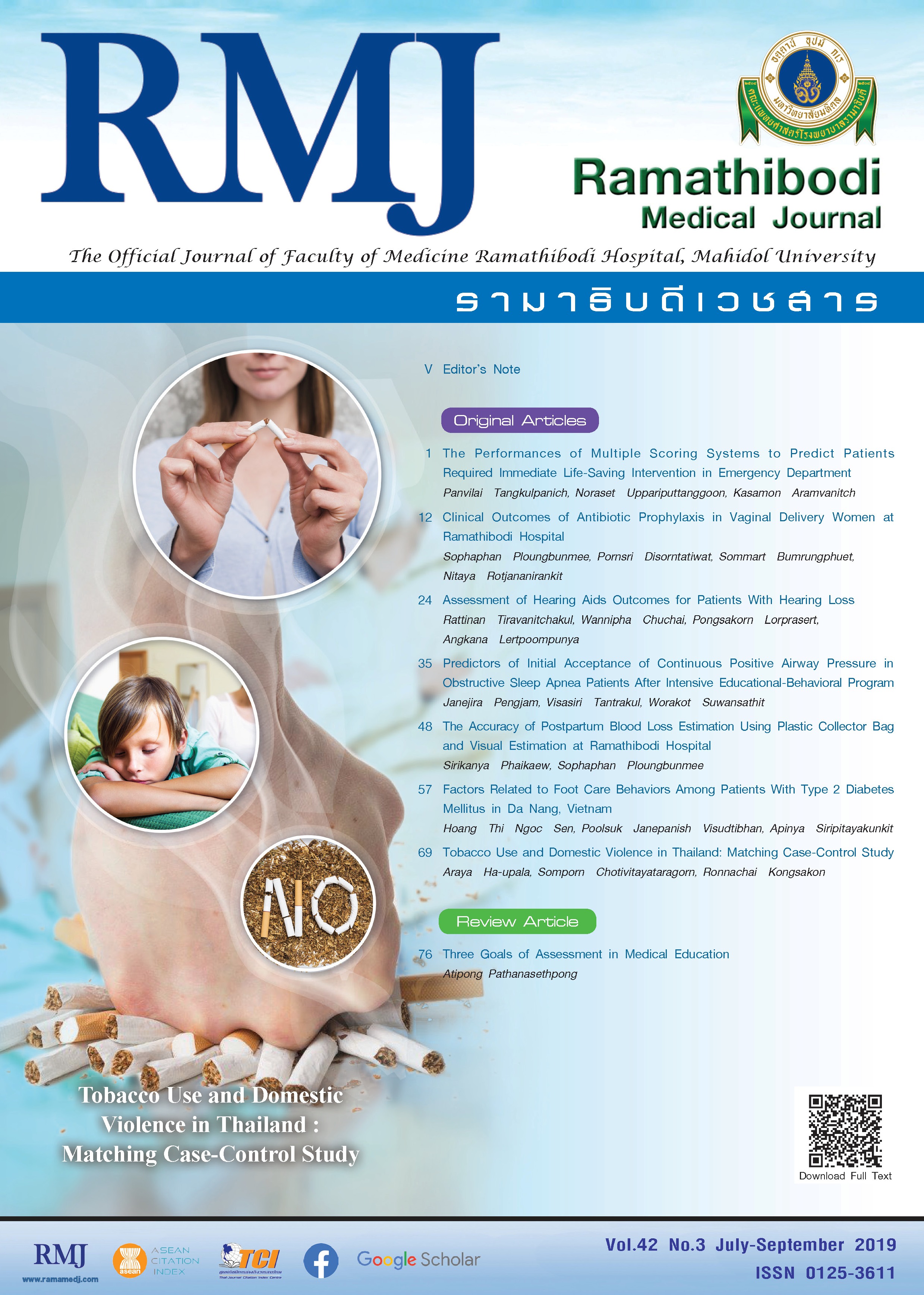The Accuracy of Postpartum Blood Loss Estimation Using Plastic Collector Bag and Visual Estimation at Ramathibodi Hospital
DOI:
https://doi.org/10.33165/rmj.2019.42.3.167280Keywords:
Plastic collector bag, Postpartum hemorrhage, Postpartum blood loss assessmentAbstract
Background: Postpartum hemorrhage is a common cause of maternal death. Accurate estimation of postpartum blood loss is important to help parturients before crisis.
Objectives: To compare estimation of postpartum blood loss and proportion of postpartum hemorrhage between plastic collector bag and visual estimation.
Methods: This study is quasi-experimental design. Participants were 20 singleton parturients, gestational age at 34 - 40 weeks and without complications during pregnancy who delivered at Ramathibodi Hospital. T test was used for comparing the difference of blood loss with Fisher exact test employed for calculating the proportion of parturients postpartum hemorrhage. The Bland-Altman method was used to determine the level of agreement between methods.
Results: Postpartum blood loss collected via a plastic collector bag was significantly more than the visual estimation (P < .05). The mean difference of postpartum blood loss between 2 methods was 112.25 with 95% confidence limits of agreement between -212.15 and 436.66.
Conclusions: The plastic collector bag was more accurate in blood loss assessment than visual estimation. It can provide early care and prevention of complications that may occur with parturients.
References
American College of Obstetricians and Gynecologists. ACOG practice bulletin: clinical management guidelines for obstetrician-gynecologists number 76, October 2006: postpartum hemorrhage. Obstet Gynecol. 2006;108(4):1039-1047.
World Health Organization. Global Health Observatory (GHO): World Health Statistics 2013. https://www.who.int/gho/publications/world_health_statistics/2013. Accessed April 21, 2019.
World Health Organization. Trends in Maternal Mortality: 1990 to 2015. Geneva, Switzerland: World Health Organization; 2015.
Annual Report Ramathibodi Obstetric-Gynecology department. Bangkok: Faculty of Medicine, Ramathibodi Hospital, Mahidol University; 2017.
Bonnar J. Massive obstetric haemorrhage. Baillieres Best Pract Res Clin Obstet Gynaecol. 2000;14(1):1-18.
Benedetti TJ. Obstetric Hemorrhage. In: Gabbe SG, Niebyi JR, Simpson JL, eds. Obstetrics Normal and Problem Pregnancies. 4th ed. New York: Churchill Livingstone; 2002.
Prata N, Mbaruku G, Campbell M. Using the kanga to measure postpartum blood loss. Int J Gynecol Obstet. 2005;89(1):49-50. doi:10.1016/j.ijgo.2005.01.019.
Lertbunnaphong T, Lapthanapat N, Leetheeragul J, Hakularb P, Ownon A. Postpartum blood loss: visual estimation versus objective quantification with a novel birthing drape. Singapore Med J. 2016;57(6):325-328. doi:10.11622/smedj.2016107.
Patel A, Goudar SS, Geller SE, et al. Drape estimation vs visual assessment for estimating postpartum hemorrhage. Int J Gynaecol Obstet. 2006;93(3):220-224. doi:10.1016/j.ijgo.2006.02.014.
Jandapradit R, Anusornteerakul S. The effectiveness of using plastic film collector bag for the measurement postpartum blood loss. Srinagarind Med J. 2015;30(3):270-275.
Cohen J. Statistical power analysis for the behavioral sciences. 2nd ed. New York: USA; 1988.
Buckland SS, Homer CS. Estimating blood loss after birth: using simulated clinical examples. Women Birth. 2007;20(2):85-88. doi:10.1016/j.wombi.2007.01.001.
Schorn MN. Measurement of blood loss: review of the literature. J Midwifery Womens Health. 2010;55(1):20-27. doi:10.1016/j.jmwh.2009.02.014.
Maslovitz S, Barkai G, Lessing JB, Ziv A, Many A. Improved accuracy of postpartum blood loss estimation as assessed by simulation. Acta Obstet Gynecol Scand. 2008;87(9):929-934. doi:10.1080/00016340802317794.
Carroli G, Cuesta C, Abalos E, Gulmezoglu AM. Epidemiology of postpartum haemorrhage: a systematic review. Best Pract Res Clin Obstet Gynaecol. 2008;22(6):999-1012. doi: 10.1016/j.bpobgyn.2008.08.004.
Patel A, Goudar SS, Geller SE, Kodkany BS, Edlavitch SA, Wagh K, et al. Drape estimation vs visual assessment for estimating postpartum hemorrhage. Int J Gynaecol Obstet. 2006;93(3):220-224. doi:10.1016/j.ijgo.2006.02.01

















